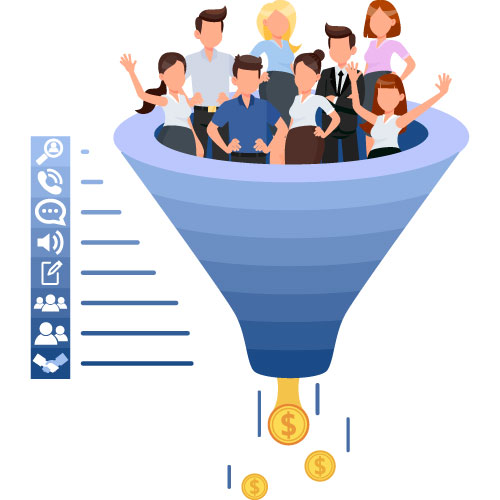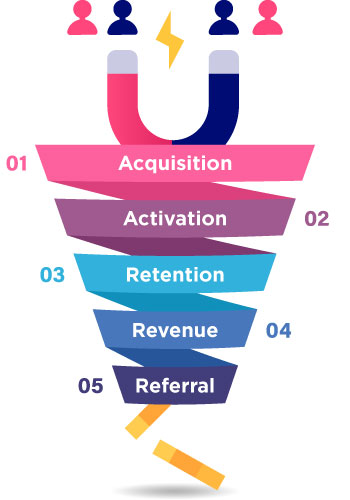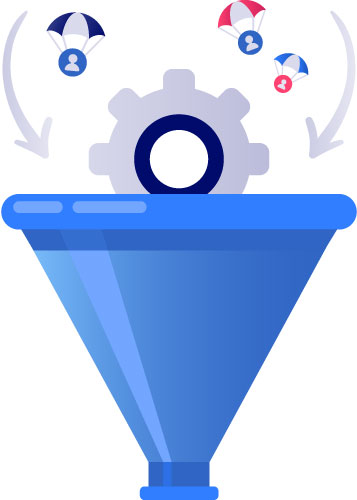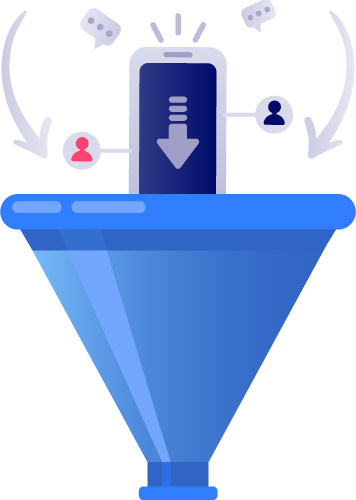As a marketer, your ultimate goal is to achieve desired results out of his marketing campaigns. You must be having all the organizational resources to make it successful. But all you want is the perfect way to integrate and apply it. Here is where funnel analysis is essential.
Funnel analysis can be used to map and analyze a series of events that lead to a particular goal. It is an effective method to find out the conversation rates on types of user behaviors. Eg. It is the flow that initiates from the user’s engagement in a mobile app and ends up in a perfect sale deal.
A funnel is a physical substance which is broader at the mouth, and which gets narrowed down its length. This allows less volume to pass through it. Funnel analysis works on a similar principle. It presents the facts about the number of users who will enter the funnel, i.e., start the transaction. Then it provides the facts and estimates about users who will complete the transaction.

Funnel analysis can provide useful information about certain bottlenecks in the transactions. Bottlenecks generally appear when users stop engaging. It helps to resolve the issues which cause user disengagement.
You can simplify future interactions with the customers once you know why they are stuck somewhere in the purchasing process. Analyzing a funnel helps you to increase the user conversion rates of an organization.
For example, an e-commerce website wants to get visitors to their website and the aim is the sale. This is known as conversion or macro-conversion. Various steps are required to start and complete sales.
The process begins with the visitor arriving at your site and ends with adding the product to the cart. Finally, he clicks on the checkout button and buys it. These steps are called goals or micro conversions.
Contents
Types of Funnel Analysis
Funnel analysis cannot be put into one type or category. It can be of various types.
Below are a few examples of types of funnel analysis:-
- E-commerce – Induce users to buy more products.
- Online Services – The goal is to convert users, increase and decrease churn.
- Mobile apps – The goal is to exaggerate user engagement.
Funnel analysis can be of the following types as per your method applications:-
- Marketing funnel analysis
- Sales funnel analysis
- Onboarding funnel analysis
Funnel analysis can be of the following types as per the project’s complexities:-
- Involves a simple project, such as a registration form filling.
- Involves more complex processes such as an app’s onboarding process.
In each of these types, You can measure the complete process from end-to-end. It starts from the first page when the visitor reach the final goal,i.e. they made a purchase. The process can even go beyond the purchasing goals.
The common thread amongst all the types is linearity. Funnel analysis is usually beneficial if you analyze a linear user journey. The analysis can help you to create processes where the user’s experience is simple. There is a straightforward way to reach the endpoint.
One can never use Funnel analysis for ascertaining the average number of purchases. You can only use it for the development of users. This applies to every business, whether it is e-commerce, SaaS, or mobile apps.
Basic Funnel Analysis Framework
A funnel analysis framework is simple to apply. It was created by Dave McClure. It is also known as the AARRR model. Marketers can apply it to most of the online businesses with necessary changes.

The AARRR model states that customers go through some typical steps in service. The steps are as follows:-
- STEP 1. Acquisition. This means that the user has visited your website or app.
- STEP 2. Activation. The user has experienced your product or service.
- STEP 3. Retention. The user returns for a repeat experience with your business.
- STEP 4. Revenue. The user purchases your product or service.
- STEP 5. Referral. The user then refers your business to acquaintances.
This is a basic model for your reference. With time, more data will be generated on your business process. Also, you get more experience with funnel analysis. The analysis can be further refined by calculating the correlations between the steps. The data helps to shift the funnel from logic-based processing to data-driven processing.
How to Create Funnel Analysis
You can easily create your funnel analysis. We are giving you the steps which will help you set up your funnel analysis in minimal time.
Step 1: Chalk out the steps of Your Funnel

The first step involves planning the methods you are going to use in your funnel. Typically a funnel consists of 4 to 8 steps. If there are more steps than that, the whole process could get very complicated. You may also not be able to analyze the amount of data generated correctly. Lesser steps can mean that a proper funnel will not even exist.
Step 2: Choose the correct and appropriate tools for your funnel analysis

If you do not have the relevant know-how to do so, you can opt for third-party tools also. It may be a better option to use third-party tools in the beginning. Now, you will not have many resources, and these tools will prove to be extremely useful.
But, as the business grows, these tools will not provide all the data that you need. Then you will have to create your custom tools. Funnel analysis tools can be built using Python, SQL, or Bash.
We are providing a few tools here which have funnel analytics features built-in.
- Google Analytics: It can be used for setting goals or enhancing e-commerce settings.
- NotifyVisitors: Its primary usage is to create heatmaps for websites. But, it also has funnel metrics built-in.
Step 3: Create and Install Funnel Visualization

It is the final step of the process. Google Data Studio or Tableau enables you to visualize a funnel.
The useful data provided by funnel analytics
Funnel analysis aims to improve user experience and process optimization. It can lead to higher user conversions. But, what data does the analysis provide? We have answered this significant question here.
There are three main ways to analyze the data
1. The “bottle-neck-check.”
It is the point in the process that causes the highest number of users to back out of the whole process. If most users are not progressing in a process after a point, then that is the bottleneck of the whole process. It is advisable to look at where the highest drop occurs.
You must take into account -both absolute numbers and business expectations. These expectations can be based on common sense. But, those expectations must have a solid base. That base can be your market benchmarks.
2. The time delay within the various steps.
This step ascertains what amount the time the user is taking at each step of the process. If any step is taking a lot of time relative to the other steps, it may lead to a significant drop in users. A user also can never make a buy decision about an expensive product when compared to an inexpensive one.
The business should provide excellent information and incentives for the expensive product. So, that users can be decisive regarding purchasing the product.
3. Use segmentation for better targeting
Different user segments may be more efficient at different steps of the process. The ascertaining of this data can help in targeting precise user segments. You may also find out why a user segment would have found a step difficult.
Eg. Men may be visiting a particular men’s goods site regularly but not purchasing anything. Then the website may go for a different approach. It may target the wives by telling them to buy a gift for their husbands.
Conclusion
You can use to find the bottlenecks in the process. They can then cut them to ensure that the user does not drop out of the process midway. Also, you can analyze user behaviour to optimize the steps. Thus, funnel analysis is an essential tool to increase user conversion significantly.

























 Email
Email SMS
SMS Whatsapp
Whatsapp Web Push
Web Push App Push
App Push Popups
Popups Channel A/B Testing
Channel A/B Testing  Control groups Analysis
Control groups Analysis Frequency Capping
Frequency Capping Funnel Analysis
Funnel Analysis Cohort Analysis
Cohort Analysis RFM Analysis
RFM Analysis Signup Forms
Signup Forms Surveys
Surveys NPS
NPS Landing pages personalization
Landing pages personalization  Website A/B Testing
Website A/B Testing  PWA/TWA
PWA/TWA Heatmaps
Heatmaps Session Recording
Session Recording Wix
Wix Shopify
Shopify Magento
Magento Woocommerce
Woocommerce eCommerce D2C
eCommerce D2C  Mutual Funds
Mutual Funds Insurance
Insurance Lending
Lending  Recipes
Recipes  Product Updates
Product Updates App Marketplace
App Marketplace Academy
Academy

